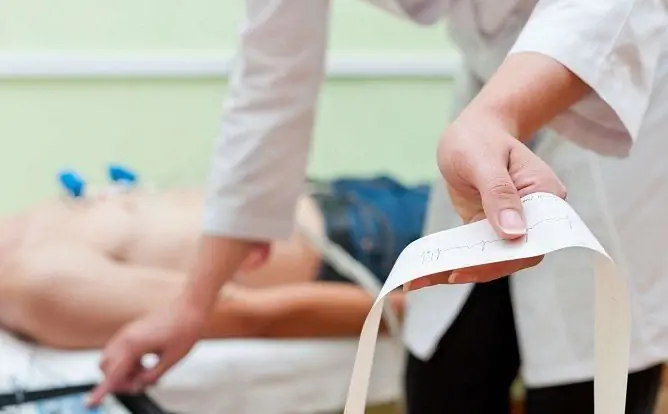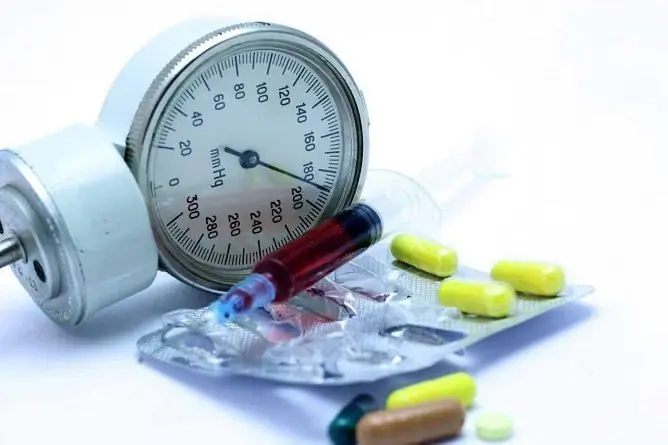- Author Rachel Wainwright [email protected].
- Public 2023-12-15 07:39.
- Last modified 2025-11-02 20:14.
Low acid gastritis
The content of the article:
- Causes and risk factors
- Forms of the disease
- Symptoms of low acidity gastritis
- Features of the course of gastritis with low acidity in children
- Diagnostics
- Treatment of gastritis with low acidity
- Diet for gastritis with low acidity
- Possible complications and consequences
- Forecast
- Prevention
Gastritis with low acidity (hypoacid gastritis) is a chronic recurrent gastroenterological disease in which an inflammatory process is formed in the gastric mucosa, the secretory activity and motor function of the stomach decrease. This form of gastritis develops less often than other clinical forms, but more often than others it leads to serious complications.
In the general structure of gastrointestinal pathology, the share of chronic gastritis is 90%, of which gastritis with low acidity accounts for about 25%. The disease is recorded in all age groups, however, it is more often found in elderly people, men and women are equally susceptible to it.

Gastritis with low acidity for a long time may be asymptomatic
Causes and risk factors
The mechanism of the onset of pathology is not fully understood. Exogenous causes of the development of gastritis with low acidity include infection with Helicobacter pylori, taking medications that have an adverse effect on the gastric mucosa, poor nutrition, the presence of bad habits, ionizing radiation, and accidental or deliberate ingestion of toxic, irritating substances.
Among the endogenous factors, genetic predisposition, pathologies of the pancreas and liver, gastroduodenal reflux, metabolic and endocrine diseases, sinusitis, renal failure, rheumatic diseases, and helminthic invasions are distinguished.
Improper treatment of acute gastritis can lead to chronicity of the pathological process. Hyperacid gastritis, in the absence of adequate treatment, is transformed over time into gastritis with low acidity.

An exogenous cause of hypoacid gastritis is infection with Helicobacter pylori
In children, gastritis with low acidity often occurs in the first years of schooling, which is associated with a change in diet against the background of increased physical and mental stress.
Forms of the disease
The main forms of chronic gastritis:
- superficial (non-atrophic);
- atrophic;
- special forms (radiation, reactive, granulomatous, eosinophilic, hypertrophic, etc.).
Depending on the etiology, gastritis is:
- autoimmune (type A);
- bacterial (type B);
- chemical (type C);
- mixed;
- alcoholic;
- medication; etc.
Depending on the localization of the pathological process:
- antrum gastritis;
- fundic gastritis;
- pangastritis.

Forms of gastritis depending on the lesion focus
Chronic gastritis with low acidity may be in remission or exacerbation. In addition, the disease can be uncomplicated and complicated (bleeding, malignancy).
Symptoms of low acidity gastritis
Gastritis with low acidity can be asymptomatic for a long time. In other cases, its leading manifestation is dyspeptic syndrome, which is caused by a pronounced violation of the functional activity of the stomach. Pain in this form of the disease is associated with stretching of the stomach, and not with muscle spasm. Usually, patients complain of a dull aching pain that appears or worsens after eating (the so-called satiated pain, in contrast to the hunger pains characteristic of gastritis with high acidity). The intensity of the pain sensation correlates with the quantity and quality of food eaten - the pain increases with the use of spicy, spicy foods. Dyskinetic disorders cause the alternation of constipation and diarrhea, the development of dumping syndrome, flatulence, and bloating.

Symptoms of low acidity gastritis
During the period of remission, the disease usually does not manifest itself in anything. During an exacerbation, there is a feeling of bitterness in the mouth, bad breath, increased salivation, belching with rotten or air, a feeling of heaviness in the epigastric region, nausea. Appetite decreases up to a complete refusal to eat.
Atrophy of the gastric mucosa, which develops with gastritis with low acidity, causes impaired absorption of nutrients and vitamins with the further development of protein-energy deficiency, hypovitaminosis, anemia. The patient's blood pressure decreases, dizziness appears after eating, dry skin, brittle hair, bleeding, increased fatigue, depression. Body weight is significantly reduced. Lactose intolerance may develop. With a long course of the disease, inflammation of the tongue and gums develops (glossitis and gingivitis).
Features of the course of gastritis with low acidity in children
In children, the disease is manifested by intense abdominal pain, which are diffuse in nature and appear after eating any food. Palpation in the epigastric region is painful. In addition, signs of gastritis with low acidity in children are nausea and vomiting, which occurs several hours after eating, and intolerance to certain foods. Children become easily excitable and emotionally unstable.

In children, gastritis with low acidity is manifested by nausea and vomiting after eating certain foods.
In this age group, superficial gastritis predominates, the glands may be damaged, but the atrophic process usually does not develop.
Diagnostics
The diagnosis of gastritis with low acidity is made on the basis of complaints, anamnesis, and the results of instrumental and laboratory tests. An ultrasound of the abdominal organs is performed, as well as an endoscopic examination - esophagogastroduodenoscopy, during which pH-metry and biopsy are also performed. Measuring the acidity of gastric contents, or pH-metry, allows you to reliably establish a decrease in the production of hydrochloric acid and pepsin.
If it is impossible to perform gastric intubation, a laboratory determination of the content of uropepsinogen in the urine is carried out. To identify the atrophic form of gastritis with low acidity, the levels of pepsinogen I and II and their relationship to each other are determined in the patient's blood. Atrophic gastritis is determined in about 85% of cases of a pronounced decrease in the level of pepsinogen. Determination of markers of autoimmune pathology (anti-parietal antibodies, and antibodies to the Castle factor) is carried out.

pH meter for gastritis measures the acidity of gastric contents
The detection of Helicobacter pylori in gastritis with low acidity can be carried out by the methods of polymerase chain reaction, enzyme immunoassay, urease breath test for Helicobacter, etc.
Differential diagnosis is carried out with stomach cancer, pellagra (vitamin PP deficiency), sprue (impaired absorption of fats, glucose and vitamins in the gastrointestinal tract), hiatal hernia, gallbladder and biliary tract dyskinesia.
Treatment of gastritis with low acidity
Treatment of gastritis with low acidity is complex, is selected individually depending on the form of the disease, the severity of secretory insufficiency, the presence of concomitant diseases and complications. The objectives of the treatment of gastritis with low acidity are:
- elimination of inflammation;
- cessation of the progression of atrophic processes in the gastric mucosa;
- restoration, as far as possible, of the motor and secretory functions of the stomach.
Treatment of the disease is usually carried out on an outpatient basis, however, in some cases (severe symptoms, the need for careful diagnosis), hospitalization may be required.
For the eradication of Helicobacter pylori, antibacterial drugs are used, as well as proton pump inhibitors (in an anacid state characterized by pH ≥ 6, proton pump inhibitors are not prescribed).

Antibiotics are used to eradicate Helicobacter pylori
According to indications, gastroprotectors, enveloping and astringent preparations, agents stimulating acid formation, vitamin and mineral complexes are used. Replacement therapy for gastritis with low acidity consists in the intake of natural gastric juice and gastric enzymes.
The main treatment of chronic gastritis with low acidity can be supplemented with physiotherapy (UHF therapy, magnetotherapy, inductometry, electrophoresis with drugs, ozokerite and paraffin applications, etc.).
Diet for gastritis with low acidity
One of the main methods of treating gastritis with low acidity is diet therapy. The success of drug therapy largely depends on how well it is observed.
Fractional meals are recommended - meals at least 5-6 times a day at approximately regular intervals, in small portions. Food should be at a comfortable temperature (warm), as cold or hot food irritates the stomach lining. Dishes are prepared using dietary methods (boiling, steaming, baking or stewing).

A gentle diet is the main treatment for gastritis with low acidity
The composition of the diet must include fermented milk products, cereals, lean fish and meat, vegetable and meat soups, pasta, eggs, vegetables, fruits, fruit juices, tea with lemon. Excludes smoked, fatty, fried foods, confectionery, whole milk, fresh baked goods, cabbage, grapes, carbonated drinks, alcohol.
Possible complications and consequences
Against the background of gastritis with low acidity, the following can develop:
- inflammatory processes in the distal gastrointestinal tract;
- ulceration of the gastric mucosa;
- pancreatitis;
- cholecystitis;
- polyhypovitaminosis;
- food allergy;
- neuropsychiatric disorders;
- malignant neoplasms.
Forecast
With timely diagnosis, timely and correct treatment, the prognosis is usually favorable, it worsens with the development of B 12 deficiency anemia. In case of malignancy, the outlook is negative.
Prevention
In order to prevent the development of gastritis with low acidity, it is recommended:
- timely and active treatment of other inflammatory diseases of the stomach that can transform into gastritis with low acidity;
- balanced diet;
- rejection of bad habits;
- compliance with hygiene rules.
YouTube video related to the article:

Anna Aksenova Medical journalist About the author
Education: 2004-2007 "First Kiev Medical College" specialty "Laboratory Diagnostics".
The information is generalized and provided for informational purposes only. At the first sign of illness, see your doctor. Self-medication is hazardous to health!






